Perhaps, there is hardly anyone who is not aware of the story of a ship’s captain’s unprecedented nightmare that the symbol of elegance, unsinkable Titanic, was sunk with all her pride deep into the bottom of the sea following a collision with a massive iceberg. Loss of Titanic was due to an accident. But most of the ships lost at sea were due to cruel force of wind, waves and water. In such circumstances, rescue of a ship is possible upto a certain extent but its survival depends on its built-in capacity and skill of her crew. At some point of time we suffer from deep anxiety when we feel small and alone floating like a tiny boat in the middle of the merciless sea. Sailors more or less meet with such a terrible experience during their voyage at sea. Some win the battle against the whimsy of nature; some, however, unfortunately succumb to it. Here I am going to describe one similar terrible experience that I came across at South China Sea.
It was an event of life and death. Even today whenever I recall that day, I become so stuffed that I cannot think any more. In 1985, as one of the members of Bangladesh Navy team I went to China to bring a newly built Submarine Chaser from Huangpu Shipyard. The new ship was named BNS NIRBHOY (which means Fearless). The name of the ship was very much appropriate because of the adventurous life of the sailors. The ship encountered a severe cyclone at the South China Sea while returning to Bangladesh.
It was August 1985, names of the team to bring the ship were declared. Three officers, including myself as Lt, had been sent to China for initial training in the first group. Other officers and sailors arrived at the Chinese port Canton afterwards. Before proceeding to China almost all the ship’s crew underwent orientation training aboard BNS DURJOY which was inducted in Bangladesh Navy in 1983. BNS DURJOY, now no more in the strength of BN, was the sister ship of NIRBHOY. Any way, all the test and trials and taking all the required preparations we were ready to return to Bangladesh. With 9 officers and 48 sailors of BN and 06 Chinese experts, we planned to set for the homeland on 13th October 1985. As, the Chinese observe the 13th day as an unlucky one, they requested us not to start the journey on that day. But we could not do so due to official obligations.
Our ship was small in size. So, a Chinese merchant ship LUFENG, which was at least 25 times larger than NIRBHOY, was with us to guide as an escort vessel up to Singapore as per contract. Our ship was following LUFENG in the large South China Sea raising murmuring sound. I felt thrilled in the wide blue sea. But our safe journey did not last long. The very next day we got the signal of an imminent cyclone. We found that many ships including Malaysian naval ships were returning for shelter.
At an early hour of 15th October, we reached close to a Chinese Naval base of the Hainan Island to replenish oil and provisions from a nearby Chinese Navy Supply Ship. Meanwhile, having got a notion of violent form of the Typhoon, and realizing the critical condition, we sought shelter from that island and informed the NHQ of our condition, Bangladesh Naval Headquarters requested all concerned authorities to give us shelter on an urgent basis. Unfortunately, we did not get any positive response for 7 hrs. The captain of escort vessel LUFENG told us that as they had bad terms with Vietnams and the naval base being strategically important, Chinese authority would not give any shelter to a foreign navy ship. Thus humanity was defeated to national security. Finding no other alternatives, we weighed anchor at 1400 hrs to take shelter on the other side of the island.
Two hours later, we saw an unimaginable change in nature. Black clouds were rushing in a great speed from one corner to another in the sky. Storm driven sea took devastating form and millions of foamy waves started rolling in a dreadful appearance. The devastating waves of the swelling sea taking the shape of mountains were running towards our ship so speedily, as if, it would sweep us all within a twinkle of an eye. Simultaneously, it also began raining. Within a moment, the thunder bolt tried to break the sky into pieces, as if, the whole sky would fall down upon our ship. There was no other sound other than the thunder clap of the furious nature, and we were totally helpless to the horrifying behavior of the sea counting every moment as a point of death and leaving no hope to life at all. The pictures, location and brief description of the Typhoon named Cecil as found from internet is given below:
All were afraid of the whimsy of the nature. Due to the tidal bore, the ship was rolling and pitching abnormally. Monster like waves were passing over the mast. All of us in the bridge were seized by panic; many got senseless. Due to severe sea-sickness and were not in a position to carryout their duties. The situation was worsening gradually. At any moment we could be lost for ever and there would be no sign of the ship anywhere. In this critical situation of life and death, many of us lost their mental balance and began to weep. Considering this very day as their last day, many of us begged pardon from the Almighty for our past misdeeds. The then supply officer late Lt Cdr Malek started reciting the holy verses loudly from the Mike “La Ila Ha Illa Anta Subhanaka inni Kuntum Minazzoalemin”. Someone started offering Azan, while others reciting different verses from the holy Quran. What a horrifying condition it was! In this circumstances, I myself had to start the stabilizer of the ship from engine room.
Cdr Badrul Amin (Commanding Officer) ordered Chief Gunnery Instructor (GI) to hold the Q/M (who steers the wheel on receiving order from the officer on watch) so that he couldn’t be splashed during the severe rolling of the ship. The Chief GI also fastened himself with the ship’s structure to give support to Q/M. After sometime the Chief Q/M began trembling abnormally. Then S Lt M A R Khan (Now Captain) had to take the charge of the wheel. In the meantime Executive Officer (EXO; 2nd in command) alerted everybody by announcing that the ship might be declared to be “Abandoned” (i.e everybody was to leave the ship). It was impossible for CO (Commanding Officer), SO (Supply Officer), MO (Medical Officer) or anyone to stay in the bridge; so they retired themselves to cabins. EXO putting his head on the side of the bulkhead, tried to remain in the bridge but after sometime he also broke down and left the bridge. Thus was going the journey in an unexplainable turmoil of the nature at sea.
Other sailors in the bridge were shivering and became paralyzed due to cold and fear of death. They were removed from the bridge to down stair. So, to keep their morale up, I assured them by telling that we were near the shore and within a short time we would beach on the land. Undoubtedly Almighty would help us. CO tried several times to come to the bridge. But he failed to climb on the ladder and thus was unable to be in the bridge. In this critical condition, If the life-rafts were operated, due to sinking of the ship, nobody would be able to get on them. Those who were with life jackets could only float in senseless condition. However, by 1800 hrs, S Lt Khan, Lt PJ Ullah (Engineer officer), myself and a sailor (named Topass Chandra Shill) somehow could survive on the bridge.
Our small ship was crossing the mountain like waves of the stormy sea. So, sometimes the waves were passing over the bridge and for the time being everything was invisible. By every thrust of the wave the ship was turning either left or right. We at once were turning the ship to the former course against the waves. Otherwise, the ship would be capsized by the next wave. The ship seemed to be a toy to the stormy sea. Whenever any wave was tumbling down the Fox’l (Front part of the ship) violently, everyone was trembling with fear. S Lt Khan told to count from 1 to 60 and in the meantime, if the ship’s head did not float, it would mean that the ship was going to sink. So, all were to jump in the water leaving all hopes. Danger was followed by danger. One side of 04 large boxes of spare barrels fixed with the gun became loose due to rolling and pitching; as such, it was continuously hitting the fox’l deck and there was a fear that it would create holes on the deck.
Everything became darker and the storm was getting much fiercer. Everyone was too weak to cry and those who were in sense were just waiting for the death ahead. At any moment the ship might capsize. S Lt Khan also became tired gradually. At 1900 hrs, he, who was the only hope left the bridge leaving the charge of the wheel on me. I, being an Engineer, did not have the experience to steer the ship even in a normal situation, let alone when the ship is at rough sea. But at that time I was the only man to remain in the open bridge.
During my cadet life I had a dream to be a seaman or a captain of a ship and though I tried twice but I became an electrical engineer. So, that time in South China Sea I got the chance to be a captain at least for a while but of course in an utmost critical situation. I was steering the ship as well as holding charge of the ship. I thanked Almighty to give me energy and morale in that critical moment. But I was thinking how long I should be going towards the unknown destination. I was afraid whether I would be able to stand or fall from the wheel. My failure from the wheel meant sinking of the ship, loosing the hope of surviving. In other way, the fighting ship NIRBHOY or FEARLESS, whatever we call it, would loose the battle against the killer Typhoon.
Everything was invisible in the darkness. My only hope was the LUFENG on the Radar Display. At about 2130 hours LUFENG was asking response from NIRBHOY. But as the Very High Frequency (VHF) set was not in my reach from the steering position I could not go there leaving the wheel. After sometime I saw that LUFENG was turning towards the opposite direction. But I was steering in the former course. The distance between LUFENG and NIRBHOY was gradually increasing. Being afraid, and in an urgent need of communication, I told the sailor Sheel to call an officer to talk through VHF. He looked for an officer but did not get any. Then leaving the wheel to sailor Sheel, I communicated with LUFENG. She told to change our course and follow her as the course was not safe. I turned the ship slowly. To turn the ship into the opposite direction was a terrible experience for me. Meanwhile, I got drenched to the skin and felt cold. The awning overhead had already been blown away by the gusty wind. At about 2200 hrs S Lt Khan came to the bridge and told me to take rest. Then I went to my cabin. But I was not at ease as I was thinking how long S Lt Khan would fight in this adversity alone.
Fear of death was continuously driving me. However, after midnight the situation improved. It seemed that we survived that time. Many things of the ship turned into haphazard condition. Meanwhile, there was no communication with the NHQ for the last 20/25 hrs. Fearing that the ship was missing, the then CNS ordered to offer prayer in all the mosques of naval bases in Bangladesh. Head of the Govt was also informed. Putting everything in order, the ship again started for Singapore. Meanwhile, one out of two stabilizers went out of operation. We were sure that if these two stabilizers became non- operational, the ship would capsize.
At the beginning of my article I have mentioned that the Chinese requested us not to start our journey back home on 13th of October as they consider like many to be unlucky. Had we listened to them and started the next day then we would have been caught by another storm called “DOT” which formed near Philippines at same time. DOT headed west-northwestward, strengthening to a tropical storm on the 13th and a typhoon on the 14th. DOT rapidly intensified to a 175 mph Super Typhoon on the 16th, the only one of the year. It crossed the South China Sea, hit southern Hainan Island and made its final landfall on northern Vietnam. It was much more perilous and cruel and recorded in Philippines as one of the 6th worst typhoon of the last 50 years. Both the successive typhoons of October 1985 are described as the most catastrophic disaster for 100 years, in which high waves combined with high tides destroyed the dike system and flooded a large area in the central part of Viet Nam and Hainan Island. And if we were caught by DOT, then I would have preferably not survived today to write this article.
At last we survived fighting against death. Some of us did not loose heart during danger. Death is inevitable, no doubt, but no one wants to die a premature death. Everybody desires a normal death. So at that time, I was unwilling to die. Perhaps my hope for life increased several times because I was near to death. I who used to say like many others “I do not fear to die” had a heart rending desire to survive in reality at least for that moment. Realizing the highest degree of danger almost all could not resist tears but I with all of my 26 years’ of gathered courage fought against the danger. The Titanic Ship (unsinkable ship) became famous for sinking and not for being luxurious and safe. In movie ‘TITANIC’ we watched what a heart rending desire of men/women to survive when the Titanic hit the iceberg and started to sink slowly in the freezing cold Atlantic with people still on it. We also who were physically in sense and sound in NIRBHOY during the crisis that day, were the real witness of that unbelievable experience. Specially to S Lt M A R Khan and to me, those moments were more difficult, because both of us had to fight alone for 4/5 hours each remaining in the margin of life and death. Might be some of the tired sailors were senseless, but some sailors realized that though they were still alive, they would die very soon when the ship would sink.
BNS NIRBHOY on her first voyage from China to Bangladesh was caught in the teeth of the storm in South China Sea. That day 3,300 boats were sunk by the Typhoon Cecil. Timely courageous actions of few sailors with the blessing of Almighty against the overwhelming force of nature saved 63 lives and the costly ship NIRBHOY. Otherwise, we would be in the Davy Jones’ locker. In no respect that battle was no less than front battle. In a combat there is a chance of self-defence or pride of self sacrifice by killing the enemy. But that day there was no chance of self-defence. Hardly we could keep the ship steady as the wind and wave of Typhoon was so devastating. However, the small but fearless Bangladesh Navy Ship fought a battle with the killer Typhoon at a battlefield far away from homeland. Finally we won the battle against the cruel force of nature, survived and returned home flying our national standard to safety. And I am proud to have been an active soldier in that battle.
Note: BNS NIRBHOY faced another severe cyclone on 29 April 1991, this time not at sea but right at Chittagong port, where she got capsized. Though she was rescued with severe damages but she lost her elder sister ship BNS DURJOY, which could not be rescued. Since then she is alone.
Track Map of Cecil
It developed on October 12 in the southeastern South China Sea. It tracked to the west-northwest, becoming a tropical storm later that day and a typhoon on the 13th. Cecil continued to intensify, and reached a peak of 115 mph winds before hitting north-central Vietnam and dissipating on the 16th.
Handing taking over trial of BNS NIRBHOY prior sailing through South China Sea in October 1985
Commodore Jasim Uddin Bhuiyan,(L), ndc, psc, BN (Retd)


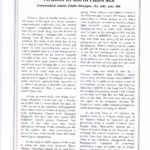
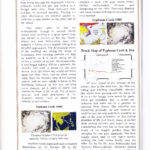
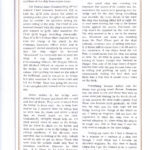
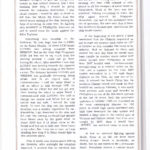
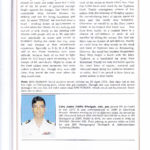
Leave A Comment